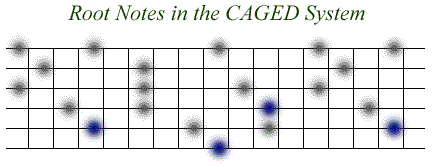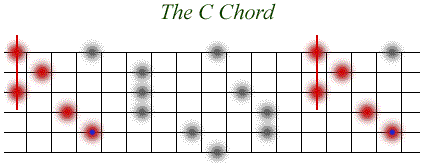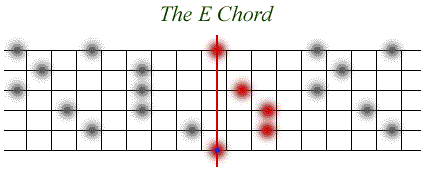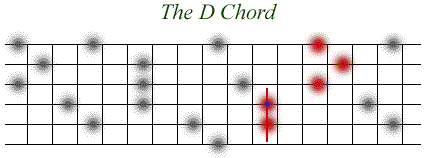
Chord Voicing
The CAGED System
After playing chords for a while, you may begin to feel that the same old open chords start to sound the same. Or perhaps you want to put different sounds into your songs using standard chords. This page will discuss a simple method of chord voicing using some complex barre chords. This method will allow anyone with a good grasp of standard barre chords to expand the sounds they can get out of a single chord. If you're sick of the same old sound, read on!
The CAGED system is a way to move the same major chords up the neck using different chord shapes and therefore giving different sounds. These are the notes contained in any major chord you play. On this diagram, no absolute frets are specified, so the diagram can start and end anywhere on the fretboard. It is meant to be a pattern which can be moved up and down the neck depending on the chord you want to play. The notes in blue are the root notes anytime they appear on the 4th, 5th, or 6th strings:

The CAGED system uses 5 barre chord shapes to arrive at different voicings for any major chord. You already know how to form A-derived and E-derived barre chords from my page on barre chord theory. The CAGED system will introduce 3 more barre chord shapes: C-derived, G-derived, and D-derived chords. These are not simple chords, and it will take a while before you can play them cleanly. However, with practice, they will become second nature. The series of diagrams below show the different shapes for the chords I just introduced. You will notice that they fit together sequentially in the order CAGED, with each chord containing the same notes but each chord sounding different. Let's go through the forms, and you'll see what I mean. In each case, the notes in the chord are shown in red, with the barred notes indicated by a red line through them. The root note of the chord is shown by a blue dot in the red circle. Each form is called a position, so that the E-derived form is two positions above the A-derived form.

The C-derived barre chords are formed using the general shape x54232, and in this case your index finger barres at the 2nd fret. The root note appears on the 5th string.

The A-derived barre chords are formed using the general shape x57775, and in this case your index finger barres at the 5th fret. The root note appears on the 5th string. Notice that the root note in the A-derived barre chord is the same as the root in the C-derived barre chord just discussed.

The G-derived barre chords are formed using the general shape 543335, and in this case your index finger barres at the 3rd fret. The root note appears on the 6th string. Notice that the notes on the 2nd, 3rd, and 4th strings in the G-derived barre chord are the same as in the in the A-derived barre chord just discussed.

The E-derived barre chords are formed using the general shape 244322, and in this case your index finger barres at the 2nd fret. The root note appears on the 6th string. Notice that the root note in the E-derived barre chord is the same as the root in the G-derived barre chord just discussed.

The D-derived barre chords are formed using the general shape x22454 or xx2454, and in this case your index finger barres at the 2nd fret. The root note appears on the 4th string. Notice that the root note in the D-derived barre chord is the same as the note on the 4th string in the E-derived barre chord just discussed. Also notice that the C-derived barre chord contains the same notes on the 1st, 2nd, and 3rd strings as this D-derived barre chord.
We have seen how to form the same major chord up the neck using five different barre chords: CAGED (in that order). So how do you use it? I'm going to use two different examples of chord progressions where you might want to use these alternate chord voices.
For the first progression, let's say you are playing the following:
F
You could play standard open chords. They'd sound good, but if you wanted to make it sound different, try using the CAGED fingering I have mentioned before. I'll go through each chord and you can refer back to the diagrams above to see where I'm coming from.